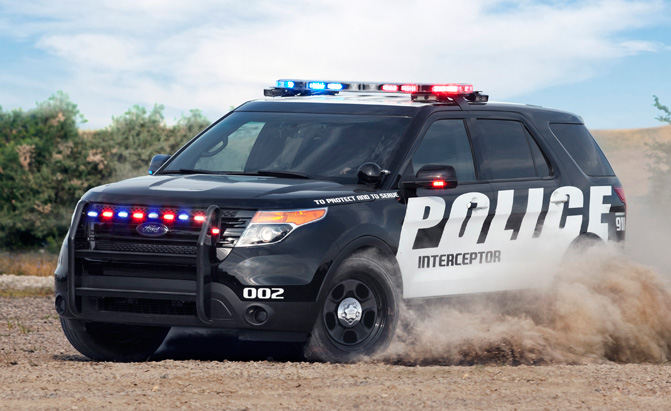Ford is working with police departments to resolve the issue with its Police Interceptor SUVs.
Ford has assembled five squads of investigators to help police departments cope with the growing number of reports of exhaust fumes incapacitating on-duty officers in Explorer-based Interceptor Utility vehicles. While the problem appears to exist in civilian spec SUVs as well, police vehicles are getting the most attention from Ford and the press, especially after the National Highway Traffic Safety Administration cited three wrecked patrol vehicles and numerous drivers looking green in the gills.
The NHTSA ramped up its engineering analysis since then, which could lead to a recall on all Explorer-based models from 2011 to 2017. But Ford hopes to get out ahead of the issue by making good on an earlier promise, dispatching its own investigative teams to ensure police departments don’t look to other automakers the next time they need to replenish their fleets.
According to Ford, it’s already making headway in solving the problem.
Bill Gubing, chief engineer for the Explorer, told the Detroit Free Press Tuesday that Ford investigators are discovering police vehicles with holes and exposed areas near the taillights or rear hatch that could allow carbon monoxide to seep into the cabin of some Interceptor Utility vehicles.
The manufacturer blames improperly installed aftermarket modifications — common on patrol cars — for the improperly sealed cabins. This would explain why the issue affects police vehicles more often than their civilian counterparts, distancing the company from the problem.
Ford has already shored up vehicles at the Auburn Police Department in Massachusetts. Last week the department was forced to remove several SUV from service after carbon monoxide exposure hospitalized three officers. It has since moved onto Austin, Texas, where the local police stopped using SUVs entirely after eight officers became ill.
SEE ALSO: NHTSA Expands Ford Explorer Probe After Reports of Carbon Monoxide Exposure in Cabin
A department in Portsmouth, New Hampshire expressed similar concerns this week and is considering suspending usage of its own Interceptor Utility fleet until Ford gets around to helping them.
“We are all concerned from the front-line officers all the way up to the chief,” explained Eric Benson, Portsmouth’s training officer. “We want to get this solved. We certainly don’t want to wait until something happens. We want to take all measures we can to ensure that not only all the officers are safe but the public as well.”
Ford stated it would pay for the cost of specific repairs to any police vehicle in any city that experienced similar issues.
“By no means is our investigation complete,” Gubing said in a statement. “We’re doing everything we can to figure out what issues are out there and how we can help.”
The Blue Oval currently carries the largest share of the police vehicle market — but less than it did when the venerable Crown Victoria was still in production. Still, when you have a feather in your cap, you’re going to want to leave it there. Ford’s scramble to right the wrong, as well as its continued broadening of its law enforcement lineup, shows it aims to keep the police on its good side.
Gubing said he doesn’t see any reason for worry among Explorer drivers not wearing a badge. “From a carbon monoxide perspective, the police duty cycle is very different than what a retail customer drives,” he said.
“It creates more combustion gas at the back of the vehicle because the engine’s working harder and faster,” Gubing continued. “At the same time, there are modifications done to the back of the vehicle that certainly provide leak paths when those modifications are not done properly.”
With no holes drilled to affix additional lighting or communication equipment on civilian SUVs, Ford assumes the general public is fine. However, that won’t stop the NHTSA from investigating more than 2,700 complaints of unpleasant exhaust odors in Explorer cabins.



Leave a Reply